2019 DODGE CHARGER SRT battery replacement
[x] Cancel search: battery replacementPage 25 of 496
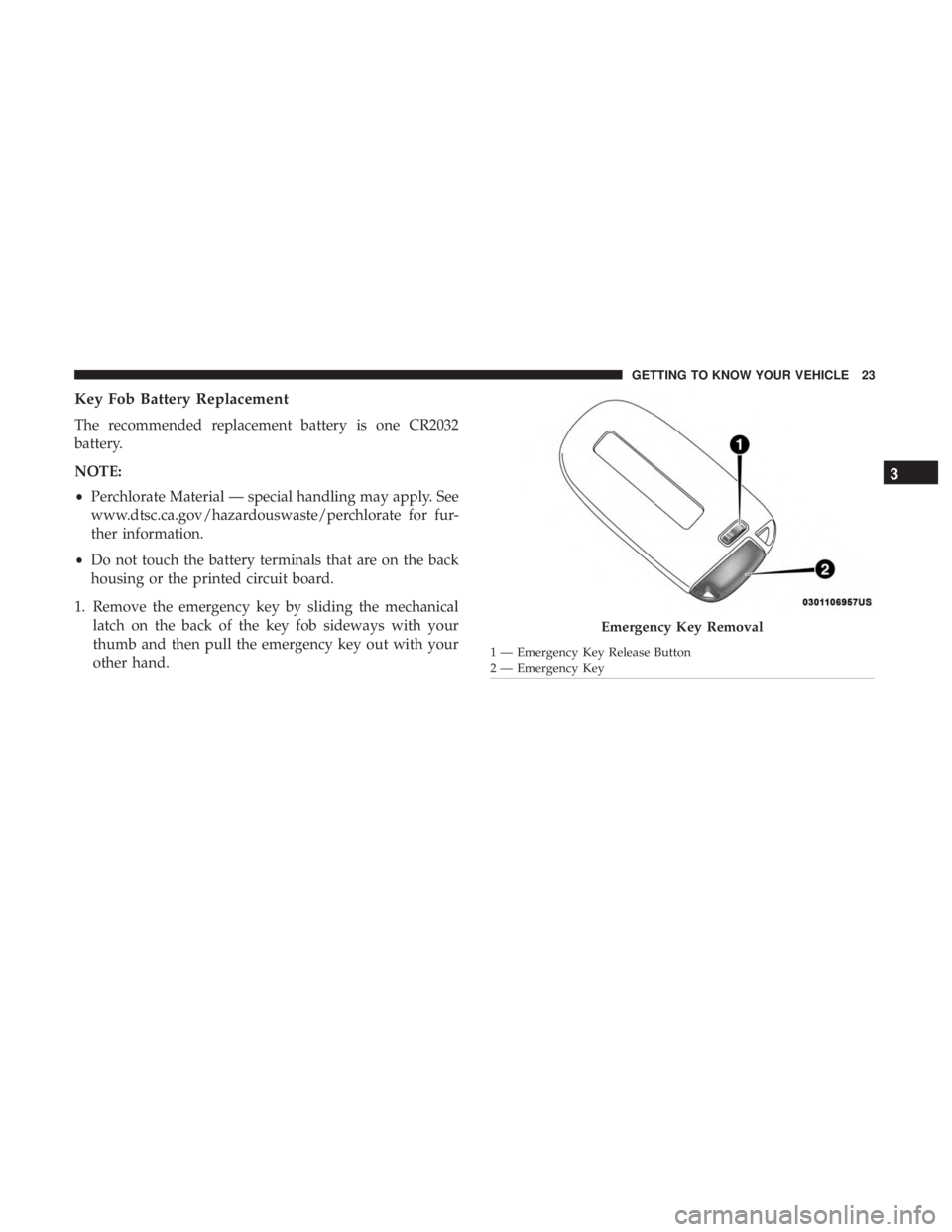
Key Fob Battery Replacement
The recommended replacement battery is one CR2032
battery.
NOTE:
•Perchlorate Material — special handling may apply. See
www.dtsc.ca.gov/hazardouswaste/perchlorate for fur-
ther information.
• Do not touch the battery terminals that are on the back
housing or the printed circuit board.
1. Remove the emergency key by sliding the mechanical latch on the back of the key fob sideways with your
thumb and then pull the emergency key out with your
other hand.
Emergency Key Removal
1 — Emergency Key Release Button
2 — Emergency Key
3
GETTING TO KNOW YOUR VEHICLE 23
Page 28 of 496
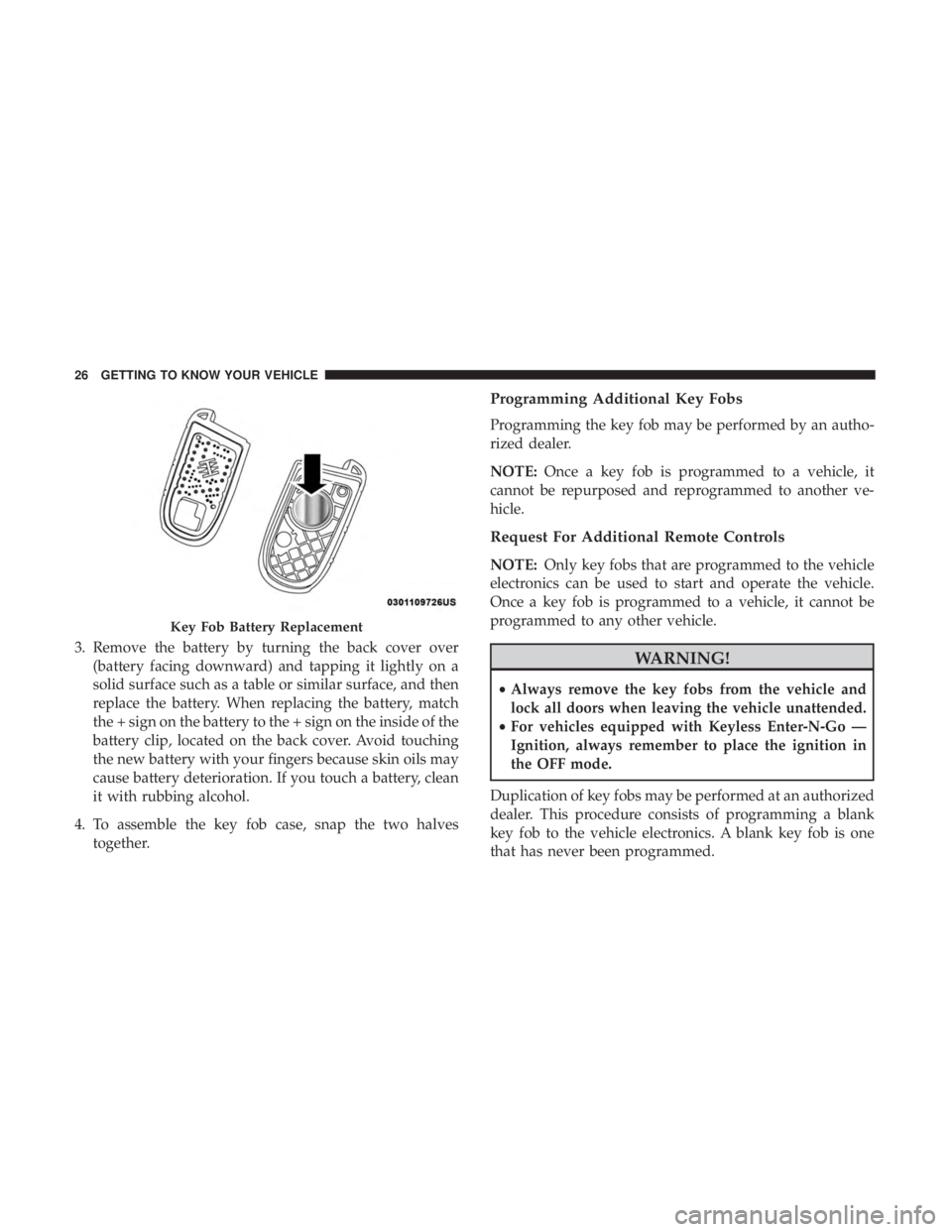
3. Remove the battery by turning the back cover over(battery facing downward) and tapping it lightly on a
solid surface such as a table or similar surface, and then
replace the battery. When replacing the battery, match
the + sign on the battery to the + sign on the inside of the
battery clip, located on the back cover. Avoid touching
the new battery with your fingers because skin oils may
cause battery deterioration. If you touch a battery, clean
it with rubbing alcohol.
4. To assemble the key fob case, snap the two halves together.
Programming Additional Key Fobs
Programming the key fob may be performed by an autho-
rized dealer.
NOTE: Once a key fob is programmed to a vehicle, it
cannot be repurposed and reprogrammed to another ve-
hicle.
Request For Additional Remote Controls
NOTE: Only key fobs that are programmed to the vehicle
electronics can be used to start and operate the vehicle.
Once a key fob is programmed to a vehicle, it cannot be
programmed to any other vehicle.
WARNING!
• Always remove the key fobs from the vehicle and
lock all doors when leaving the vehicle unattended.
• For vehicles equipped with Keyless Enter-N-Go —
Ignition, always remember to place the ignition in
the OFF mode.
Duplication of key fobs may be performed at an authorized
dealer. This procedure consists of programming a blank
key fob to the vehicle electronics. A blank key fob is one
that has never been programmed.
Key Fob Battery Replacement
26 GETTING TO KNOW YOUR VEHICLE
Page 137 of 496
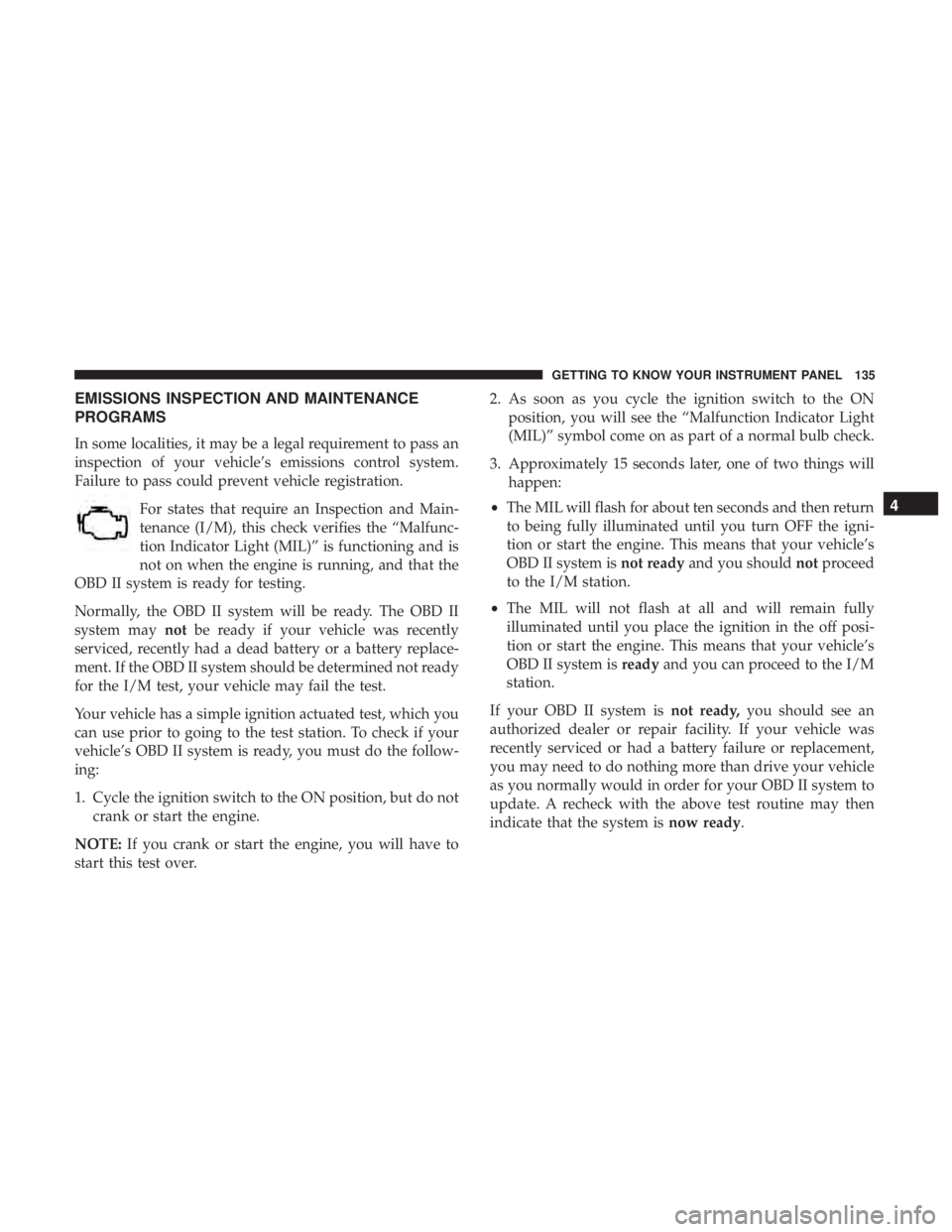
EMISSIONS INSPECTION AND MAINTENANCE
PROGRAMS
In some localities, it may be a legal requirement to pass an
inspection of your vehicle’s emissions control system.
Failure to pass could prevent vehicle registration.For states that require an Inspection and Main-
tenance (I/M), this check verifies the “Malfunc-
tion Indicator Light (MIL)” is functioning and is
not on when the engine is running, and that the
OBD II system is ready for testing.
Normally, the OBD II system will be ready. The OBD II
system may notbe ready if your vehicle was recently
serviced, recently had a dead battery or a battery replace-
ment. If the OBD II system should be determined not ready
for the I/M test, your vehicle may fail the test.
Your vehicle has a simple ignition actuated test, which you
can use prior to going to the test station. To check if your
vehicle’s OBD II system is ready, you must do the follow-
ing:
1. Cycle the ignition switch to the ON position, but do not crank or start the engine.
NOTE: If you crank or start the engine, you will have to
start this test over. 2. As soon as you cycle the ignition switch to the ON
position, you will see the “Malfunction Indicator Light
(MIL)” symbol come on as part of a normal bulb check.
3. Approximately 15 seconds later, one of two things will happen:
• The MIL will flash for about ten seconds and then return
to being fully illuminated until you turn OFF the igni-
tion or start the engine. This means that your vehicle’s
OBD II system is not readyand you should notproceed
to the I/M station.
• The MIL will not flash at all and will remain fully
illuminated until you place the ignition in the off posi-
tion or start the engine. This means that your vehicle’s
OBD II system is readyand you can proceed to the I/M
station.
If your OBD II system is not ready,you should see an
authorized dealer or repair facility. If your vehicle was
recently serviced or had a battery failure or replacement,
you may need to do nothing more than drive your vehicle
as you normally would in order for your OBD II system to
update. A recheck with the above test routine may then
indicate that the system is now ready.
4
GETTING TO KNOW YOUR INSTRUMENT PANEL 135
Page 319 of 496
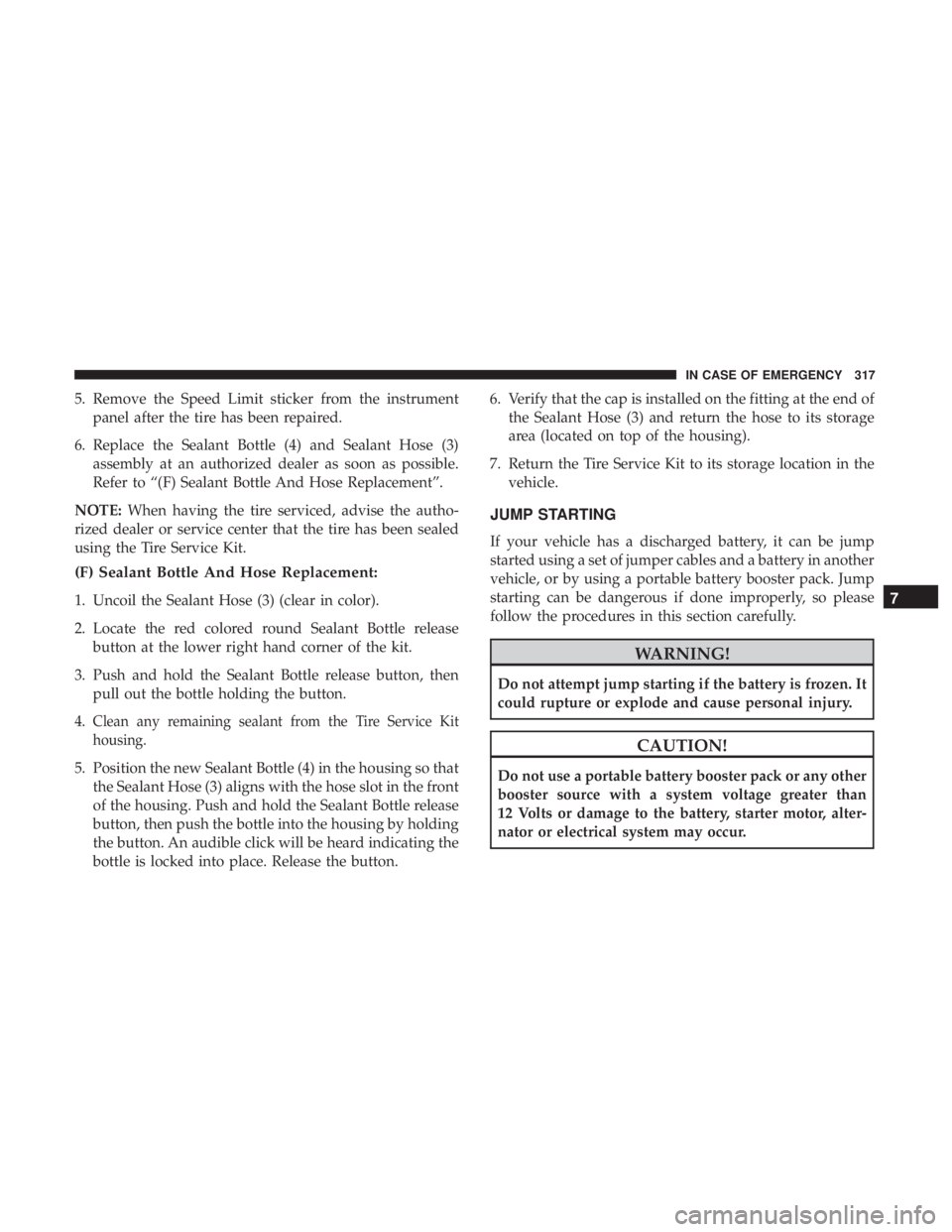
5. Remove the Speed Limit sticker from the instrumentpanel after the tire has been repaired.
6. Replace the Sealant Bottle (4) and Sealant Hose (3) assembly at an authorized dealer as soon as possible.
Refer to “(F) Sealant Bottle And Hose Replacement”.
NOTE: When having the tire serviced, advise the autho-
rized dealer or service center that the tire has been sealed
using the Tire Service Kit.
(F) Sealant Bottle And Hose Replacement:
1. Uncoil the Sealant Hose (3) (clear in color).
2. Locate the red colored round Sealant Bottle release button at the lower right hand corner of the kit.
3. Push and hold the Sealant Bottle release button, then pull out the bottle holding the button.
4.
Clean any remaining sealant from the Tire Service Kit
housing.
5. Position the new Sealant Bottle (4) in the housing so that the Sealant Hose (3) aligns with the hose slot in the front
of the housing. Push and hold the Sealant Bottle release
button, then push the bottle into the housing by holding
the button. An audible click will be heard indicating the
bottle is locked into place. Release the button. 6. Verify that the cap is installed on the fitting at the end of
the Sealant Hose (3) and return the hose to its storage
area (located on top of the housing).
7. Return the Tire Service Kit to its storage location in the vehicle.
JUMP STARTING
If your vehicle has a discharged battery, it can be jump
started using a set of jumper cables and a battery in another
vehicle, or by using a portable battery booster pack. Jump
starting can be dangerous if done improperly, so please
follow the procedures in this section carefully.
WARNING!
Do not attempt jump starting if the battery is frozen. It
could rupture or explode and cause personal injury.
CAUTION!
Do not use a portable battery booster pack or any other
booster source with a system voltage greater than
12 Volts or damage to the battery, starter motor, alter-
nator or electrical system may occur.
7
IN CASE OF EMERGENCY 317
Page 481 of 496

Arming SystemSecurity Alarm ...........................35
Assist, Hill Start .......................... .145
Audio Systems (Radio) ...................... .399
Auto Down Power Windows ...................83
Automatic Door Locks ........................42
Automatic Headlights ........................65
Automatic High Beams .......................64
Automatic Temperature Control (ATC) ..........74, 79
Automatic Transmission ..................... .222
Adding Fluid .....................355, 393, 395
Fluid And Filter Change ...................355
Fluid Change .......................... .355
Fluid Level Check .....................354, 355
Fluid Type ...................... .354, 393, 395
Special Additives ........................ .355
Automatic Transmission Limp Home Mode .....42, 227
AutoPark ............................... .214
Autostick Operation ............................. .228
Auto Up Power Windows .....................83
AUXCord .............................. .454
Auxiliary Electrical Outlet (Power Outlet) .........102
Axle Fluid ........................... .393, 395Axle Lubrication
....................... .393, 395
Back-Up ................................ .271
Battery .............................. .124, 335
Charging System Light ....................124
Keyless Key Fob Replacement ................23
Location .............................. .335
Belts, Seat ............................... .205
Body Mechanism Lubrication ..................343
B-Pillar Location .......................... .361
Brake Assist System ........................ .139
Brake Control System ....................... .139
Brake Fluid ....................... .353, 393, 395
Brake System ......................... .352, 386
Fluid Check ..................... .353, 393, 395
Master
Cylinder ........................ .353
Parking .............................. .218
Warning Light ...................... .122, 386
Brake/Transmission Interlock ..................222
Brightness, Interior Lights .....................70
Bulb Replacement ......................... .289
Bulbs, Light .......................... .207, 289
Camera, Rear ............................ .271
Capacities, Fluid .......................... .392
12
INDEX 479
Page 486 of 496
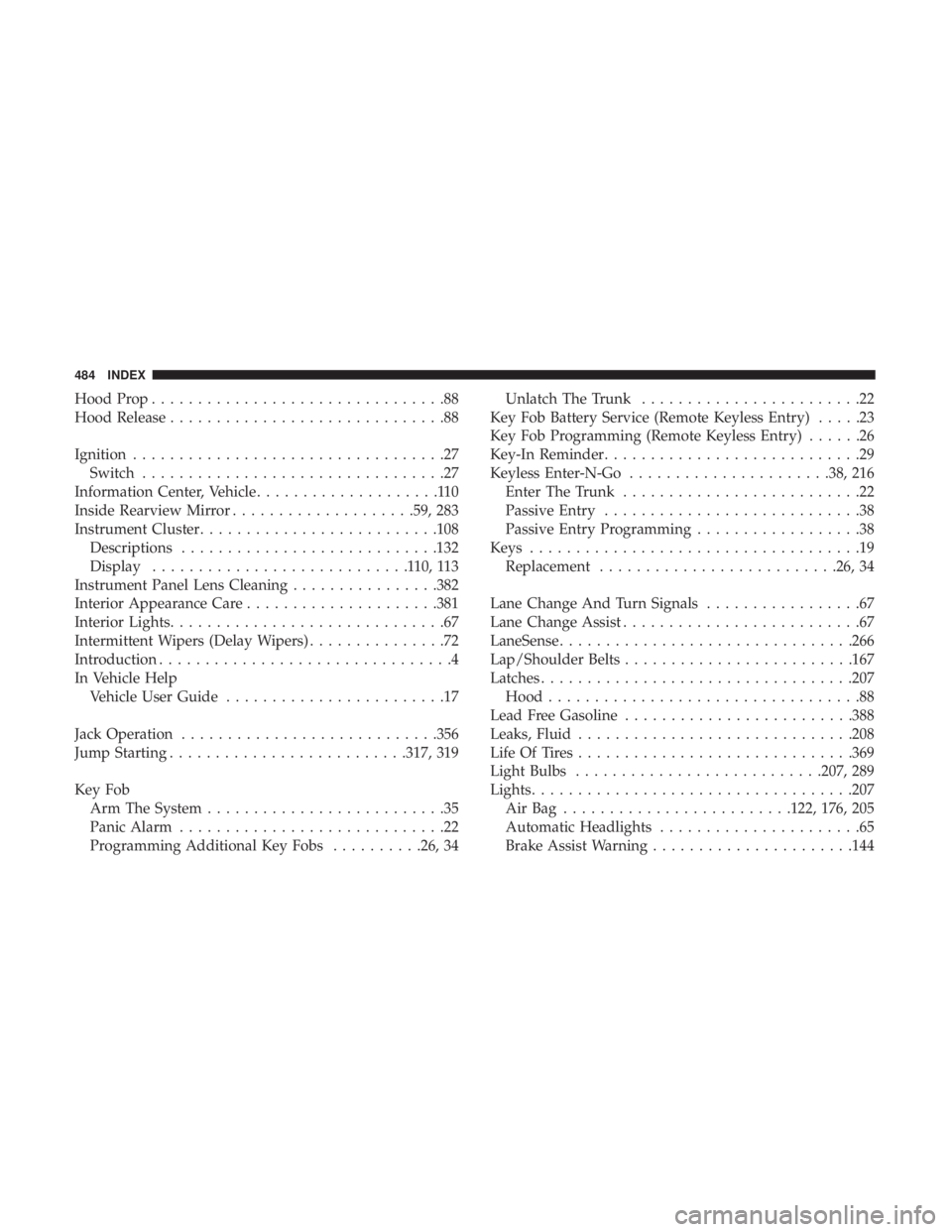
Hood Prop................................88
Hood Release ..............................88
Ignition ..................................27
Switch .................................27
Information Center, Vehicle ....................110
Inside Rearview Mirror ....................59, 283
Instrument Cluster ......................... .108
Descriptions ........................... .132
Display ............................110,113
Instrument Panel Lens Cleaning ................382
Interior Appearance Care .....................381
Interior Lights ..............................67
Intermittent Wipers (Delay Wipers) ...............72
Introduction ................................4
In Vehicle Help Vehicle User Guide ........................17
Jack Operation ........................... .356
Jump Starting ......................... .317, 319
Key Fob Arm The System ..........................35
Panic Alarm .............................22
Programming Additional Key Fobs ..........26, 34Unlatch The Trunk
........................22
Key Fob Battery Service (Remote Keyless Entry) .....23
Key Fob Programming (Remote Keyless Entry) ......26
Key-In Reminder ............................29
Keyless Enter-N-Go ..................... .38, 216
Enter The Trunk ..........................22
Passive Entry ............................38
Passive Entry Programming ..................38
Keys ....................................19
Replacement ......................... .26, 34
Lane Change And Turn Signals .................67
Lane Change Assist ..........................67
LaneSense ............................... .266
Lap/Shoulder Belts ........................ .167
Latches ................................. .207
Hood ..................................88
Lead Free Gasoline ........................ .388
Leaks, Fluid ............................. .208
Life Of Tires ............................. .369
Light Bulbs .......................... .207, 289
Lights .................................. .207
A
irBag .........................122, 176, 205
Automatic Headlights ......................65
Brake Assist Warning ..................... .144
484 INDEX
Page 487 of 496
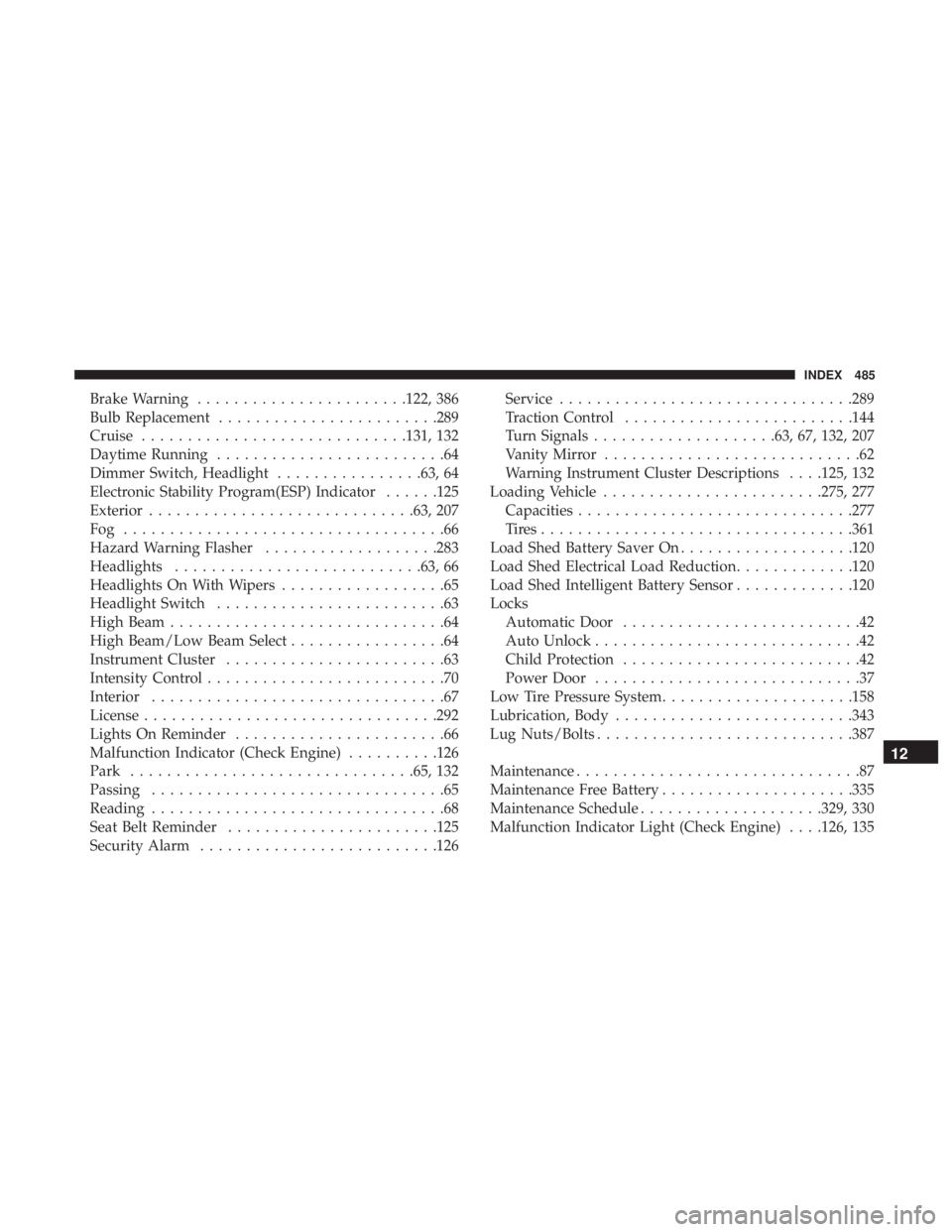
Brake Warning...................... .122, 386
Bulb Replacement ....................... .289
Cruise ............................ .131, 132
Daytime Running .........................64
Dimmer Switch, Headlight ................63, 64
Electronic Stability Program(ESP) Indicator ......125
Exterior ............................ .63, 207
Fog ...................................66
Hazard Warning Flasher ...................283
Headlights .......................... .63, 66
Headlights On With Wipers ..................65
Headlight Switch .........................63
High Beam ..............................64
High Beam/Low Beam Select .................64
Instrument Cluster ........................63
Intensity Control ..........................70
Interior ................................67
License ............................... .292
Lights On Reminder .......................66
Malfunction Indicator (Check Engine) ..........126
Park .............................. .65, 132
Passing ................................65
Reading ................................68
Seat Belt Reminder ...................... .125
Security Alarm ......................... .126Service
............................... .289
Traction Control ........................ .144
Turn Signals ....................63, 67, 132, 207
Vanity Mirror ............................62
Warning Instrument Cluster Descriptions . . . .125, 132
Loading Vehicle ....................... .275, 277
Capacities ............................. .277
Tires................................. .361
Load Shed Battery Saver On ...................120
Load Shed Electrical Load Reduction .............120
Load Shed Intelligent Battery Sensor .............120
Locks Automatic Door ..........................42
Auto Unlock .............................42
Child Protection ..........................42
Power Door .............................37
Low Tire Pressure System .....................158
Lubrication,
Body ......................... .343
Lug Nuts/Bolts ........................... .387
Maintenance ...............................87
Maintenance Free Battery .....................335
Maintenance Schedule ....................329, 330
Malfunction Indicator Light (Check Engine) . . . .126, 135
12
INDEX 485